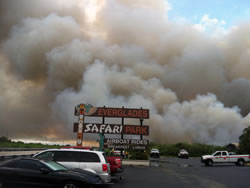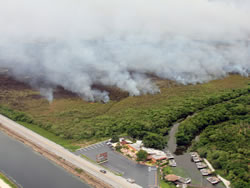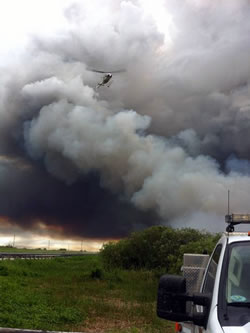National Cohesive Wildland Fire Management Strategy Success Story
Park Manages Multiple Wildfires in the Wildland Urban Interface
Everglades National Park, Florida
Cohesive Strategy - Response to Wildfire
2011

Public information officers and wildland fire engines staged at an airboat tour facility during the Afternoon Fire, which provided opportunities to educate the public about wildland fire and the benefits of fire in the Everglades.

The Afternoon Fire burned adjacent to Highway US 41 and airboat tour facilities.

Aviation and ground resources on the Afternoon Fire.
On August 8, 2011, Everglades National Park firefighters responded to a lightning-ignited fire near the northern boundary of the park. The 10,423 acre Afternoon Fire burned in long-unburned sawgrass adjacent to Highway US 41, a major transportation corridor, where private homes, businesses and airboat tour facilities are located. Because of the fire’s proximity to the Wildland Urban Interface (WUI), coordination with stakeholders as well as federal and state agencies ensured safe and effective management of the potentially dangerous fire. Extensive communication with the public and local businesses was essential. Smoke impacts along the highway and impacts to airboat tour operations were minimal and the fire provided an opportunity to describe the ecology and benefits of fire to the public. Several air and ground resources were managed simultaneously without significant incident. Two single engine airtankers (SEATs), two type 3 helicopters and 4 engines with staff from Federal and state agencies were dedicated to the Afternoon Fire. An Everglades Fire Public Information Officer (PIO) was on scene to provide information to Airboat tour operators and the public.
Interagency partnerships with multiple agencies was necessary early to ensure successful management of the fire. The following agencies assisted Everglades’ firefighters in managing the Afternoon Fire:
- U.S. Fish and Wildlife Service Loxahatchee National Wildlife Refuge
- Florida State Forest Service
- Miami Dade Fire Rescue
- Miccosukee Tribe of Indians of Florida
- Florida Highway Patrol
Between July and August, Everglades Fire Management managed five wildfires, three simultaneously, totaling approximately 18,800 acres. Two days after the start of the Afternoon fire, a storm front moved through and lightning ignited the Coptic Fire and the South Fire, requiring firefighters to respond to and manage three wildfires concurrently. The Afternoon Fire totaled 10,423 acres, the Coptic Fire was declared out at 17 acres and the South Fire was less than 1 acre just outside the park boundary. The Cutoff Fire, started on August 18th, 2011, was 925 acres on the western portion of the park and the Shanty Fire, ignited less than a week later, totaled 7,491 acres immediately adjacent to the Afternoon Fire along the northern boundary of the park. In addition to managing several wildfires, three planned ignition treatments were completed during the same time period for a total of 1,404 acres.
The successful management of these wildfires resulted in ecological benefits to the ecosystem while adverse impacts in the Wildland Urban Interface were avoided. The management of the wildfires and implementation of the prescribed fires has accomplished significant fire ecology and restoration goals, like hazardous fuel reduction. These treatments provide protection for extensive areas of Wildland Urban Interface in and around Everglades National Park. Sensitive cultural resource sites and endangered species nesting sites were successfully protected during the management of these wildfires. It is expected that foraging habitat for threatened and endangered species will be enhanced by both the wildfire and planned ignition treatments conducted by Everglades National Park.
Contact
Rick Anderson, Fire Management Officer
Email: Rick_Anderson@nps.gov
Phone: (305) 242-7853
Keywords: Partnerships, Fire Ecology and Restoration